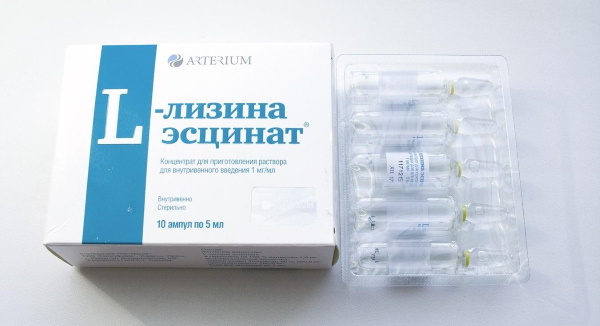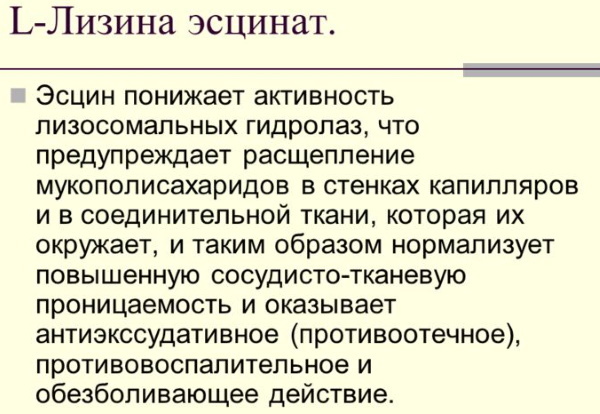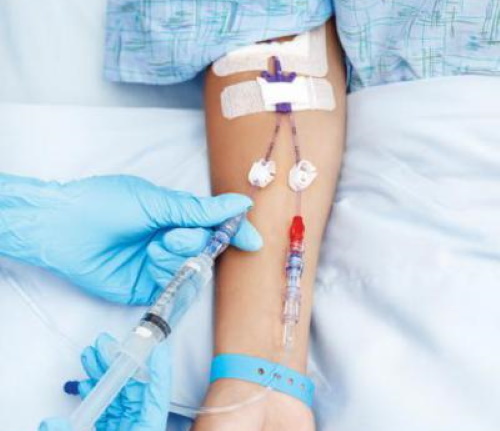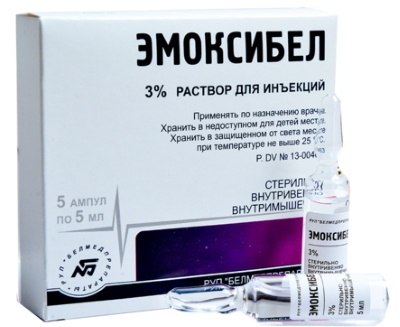L-lysine escinate refers to a broad spectrum of actionregulating the work of the central nervous system and the circulatory system. The price of the medication is quite high, but it is justified by its effectiveness. The drug should be used only according to indications and in the absence of contraindications.
Record content:
- 1 Forms of release and composition of the drug
- 2 Pharmacological properties
- 3 Pharmacodynamics and pharmacokinetics
- 4 Indications for use
- 5 Contraindications
- 6 At what age can the drug be used?
- 7 Instructions for use, dosage
- 8 Side effects
- 9 Overdose
- 10 special instructions
- 11 Drug interactions
- 12 Analogs
- 13 Terms, conditions of sale and storage
- 14 Price
- 15 Video about L-lysine escinat
Forms of release and composition of the drug
The medication can be found on pharmacy shelves in the form of a parenteral solution. It is a clear, colorless liquid without a pungent odor, packaged in 5 ml ampoules. Ampoules are placed in cardboard boxes of 10 pieces, detailed instructions are attached to them.
When shaking the ampoule, bubbles form in the solution, which are rather difficult to remove; when added to another solution, a small amount of white foam can be seen. The product contains the active ingredient escin lysinate, which has a pronounced therapeutic effect.

The following ingredients are present as additional substances in the solution:
- Purified water.
- Propylene glycol.
- Ethanol.
1 ml of concentrated solution accounts for 1 mg of active ingredient, that is, in 1 ampoule, its amount reaches 5 mg.
Pharmacological properties
L-lysine escinate (the price of the product is quite high) has moderate hypoglycemic and pronounced anti-edema properties. The tool also has analgesic properties, which makes it possible to use it for the treatment of pathologies accompanied by severe prolonged pain.
The drug stimulates the formation of new cells, promotes tissue renewal by improving metabolic processes in membranes. As a result, recovery is accelerated and the progression of the pathological condition is prevented.
The drug also has a positive effect on the walls of blood vessels, which reduces the risk of re-development of peripheral edema or edema of nerve tissues as a result of injuries and some other diseases. The complex effect of the drug allows it to be used in various pathological conditions.
Pharmacodynamics and pharmacokinetics
The drug begins to act almost immediately after parenteral administration. The active ingredient of the composition belongs to amino acids, is concentrated in the systemic circulation and helps to strengthen the vascular walls, which prevents capillary fragility and the appearance of peripheral edema against the background of damage to the cardiovascular and central nervous systems.

The substance in the composition helps to eliminate existing edema, makes the vessels elastic and strong. Against the background of its use, an improvement in microcirculation is noted, the supply of oxygen and nutrients to the tissues is normalized.
The medicine helps to relieve pain in:
- muscles;
- articular joints;
- spinal column.
The positive effect of the active component on the brain tissue is noted.
The tool has other properties:
- Improves the condition of peripheral veins, for example, with lesions of the vessels of the lower extremities of inflammatory origin. With phlebitis and thrombophlebitis, the progression of the disease slows down.
- Prevents the development of seizures in patients with a tendency to such lesions.
- Facilitates the work of the heart by reducing the volume of circulating blood.
- Prevents dysfunction of the brain as a result of trauma and the development of edema.
- Helps to accelerate the process of restoration of nerve tissue in neurological diseases of inflammatory origin.
- Stimulates the development of new cells and improves metabolism in their membranes, which promotes faster regeneration.
- Increases endurance by improving muscle metabolism.
In combination with other medicines, the effectiveness of therapy is significantly increased.
After parenteral administration of the solution, its rapid spread through the systemic circulation is observed. The substance is concentrated in the blood and penetrates into the synovial fluid of the articular joints, is found in the cerebrospinal fluid. The processing of the active ingredient is carried out in the patient's liver. Decay products are evacuated by the kidneys.

The ingredient does not accumulate in the body in large quantities. Within 24 hours, it is completely removed. In patients with kidney and digestive tract pathologies, a slight slowdown in the absorption of active substances is observed, which may somewhat weaken the therapeutic effect. With a severe course of the disease, the effectiveness is weakened significantly.
Slowing down the elimination of ingredients from the body against the background of renal failure can lead to an increase in the concentration of the ingredient in the tissues and the development of an overdose.
Indications for use
L-lysine escinate is often prescribed, despite the high price of the medication. The main indications for prescribing a medicine:
- Edema of the brain of traumatic and non-traumatic origin.
- Pathologies of the spinal column, accompanied by degenerative-dystrophic changes in cartilage tissue. With osteochondrosis, the drug helps not only to stop the progression of the disease, but also helps to improve the condition of the tissues.
- Thrombophlebitis in the acute stage, accompanied by severe inflammatory manifestations and impaired venous blood flow.
- Spinal cord edema on the background of inflammatory pathologies or injuries.
- Diagnosis of intracranial hematoma of various origins, in which disorders of the central nervous system are observed.
- Subarachnoid hematomas.
- Swelling of soft tissues against the background of lesions of the musculoskeletal system. The tool can be used for radiculitis in the acute stage, arthritis with pronounced external manifestations in the form of tissue edema and local temperature rise.
- Soft tissue injuries with bruises, sprains, accompanied by swelling and severe pain.

The drug is used not only in the acute stage of pathologies. Often, patients with neurological disorders of chronic origin are regularly treated with medication in order to prevent exacerbation of the disease.
Contraindications
The drug is contraindicated for use in case of intolerance to its components or a tendency to similar disorders in the patient's history.
There are other barriers to prescribing medication:
- Bleeding of unspecified origin. The medication is contraindicated for internal and external bleeding that occurs in patients against a background of various diseases or injuries.
- Lactation and pregnancy. The tool is considered dangerous not only for the child, but also for the mother.
- Severe hepatic impairment with severe organ dysfunction. The remedy may be contraindicated in hepatitis and cirrhosis of the liver, as well as fatty hepatosis.
- Renal failure With such a violation, the process of excretion of the active substance is significantly impaired, therefore, the risk of developing an overdose increases.
- Exacerbation of bronchial asthma.

- Heart pathology in acute form.
- Hereditary blood pathologies, accompanied by coagulation disorders.
- A temporary decrease in the number of platelets and coagulation factors during the use of anticoagulants and some other drugs.
The medication is not used in the acute period after a myocardial infarction, as it can lead to the development of complications. For elderly patients, it is prescribed with caution and after a preliminary examination. Such patients often suffer from chronic pathologies, therefore, treatment can provoke an aggravation of symptoms.
At what age can the drug be used?
L-lysine escinate (the price of the product differs in different pharmacies) is prescribed for patients over 18 years of age. At an earlier age, the use can provoke complications.
Instructions for use, dosage
The drug is intended only for intravenous infusion using a dropper after preliminary addition of 0.9% to 100-200 ml of physiological solution. The agent cannot be administered intra-arterially or intramuscularly. Infusion with a syringe is also not allowed.

Only in some cases do specialists allow very slow injection with a syringe, but this is usually necessary when conditions develop that threaten the patient's life.
The standard therapy regimen assumes a slow infusion using a dropper:
- 5 or 10 ml of the agent is added to the bottle with saline, depending on the patient's condition. Usually such treatment is carried out in a hospital setting. The therapy lasts up to 14 days. The daily dosage is not increased if the patient is undergoing planned treatment.
- In severe cases, an increase in the norm to 20 ml per day is allowed, but such therapy lasts no more than 5 days. After infusion, the patient is in a horizontal position for 1-2 hours.
Repeated courses are allowed at intervals of 5-6 months. It is forbidden to independently increase the dose or prolong the course.
Side effects
L-lysine escinate (the price may vary depending on the manufacturer of the medication) often leads to the development of negative reactions from the internal organs and systems.
Complications arise when you violate the rules prescribed in the instructions:
| Organs and systems | The most common complications |
| Nervous system | Dizziness and tremors of the limbs appear quite often during therapy. Patients may talk about the development of severe migraine headaches, which are not eliminated with the help of conventional analgesics. The condition worsens with the appearance of weakness, drowsiness. In some patients, the use of the drug provokes sleep disorders, the flashing of flies in front of the eyes and a temporary deterioration in vision. |
| Respiratory system | Shortness of breath when using the drug appears in patients who suffer from chronic pathologies of the respiratory system. With the continuation of the course, an unproductive cough appears, there is a feeling of lack of air. The condition often leads to an exacerbation of the underlying disease. |
| Digestive tract | From the side of the digestive tract, complications rarely occur, accompanied by a burning sensation in the stomach, nausea and bouts of vomiting. Against the background of dyspeptic disorders, there is a deterioration in appetite, stool disturbance, flatulence and bloating. |
| Vessels and heart | During the treatment period, patients may experience pain in the region of the heart, there is a change in blood pressure indicators, tachycardia. Sometimes in elderly patients, the condition is accompanied by a violation of the heart rhythm. |
| Skin, mucous membranes | Allergy to medication is rare, but almost always accompanied by severe disorders in the form of rash and itching of the skin, peeling and irritation. The condition can be aggravated by general symptoms such as weakness, swelling of the mucous membranes of the mouth, nasal passages and eyes. Puffiness is accompanied by itchy eyes, irritation and redness. |

The agent can also provoke chills, local reactions in the injection area in the form of a sensation of heat, pain and severe burning. Reactions can occur during the infusion of the solution or after the procedure. With the aggravation of the symptoms, the condition does not normalize after the end of the course, sometimes surgical intervention is required to eliminate purulent foci that appear against the background of pronounced phlebitis.
Overdose
The medication can provoke an overdose in case of violation of the instructions and prolonged administration of increased doses of the solution. In this case, the patient is worried about severe pain in the stomach, aggravated by a burning sensation. Palpitations and pain in the region of the heart worsen the condition.
Immediately during and after the introduction, the patient feels a flush of heat, in which there is profuse sweating and thirst. Dryness of the mucous membranes of the oral cavity provokes irritation, tissue damage when eating solid food.
Overdose is often accompanied by an acute allergic reaction, manifested by various symptoms:
- Large red spots on the patient's body. As the condition progresses, their spread to large areas of the skin is observed.
- Severe itching and burning of the skin when scratching the lesions.
- Deterioration of general well-being as a result of constant scratching of lesions, the appearance of increased irritability and the development of a depressive state.
- The emergence of the risk of skin infection as a result of damage to its outer layer.
- Swelling of the mucous membranes of the throat and deterioration of the passage of air into the lower respiratory tract. Sometimes the condition can provoke suffocation as a result of the complete blockage of the airways.
- Weakness and drowsiness.

In case of an overdose, it is important to stop using the product immediately and consult a doctor for help. The drug does not have a specific antidote, therefore, therapy involves the appointment of funds depending on the symptomatology. The patient's condition usually returns to normal 3-5 days after the start of therapy.
special instructions
L-lysine escinate (the price of the medication depends on the number of ampoules in the package) is not prescribed without preliminary examination, measurement of heart rate and blood pressure. Regular monitoring of these parameters will reduce the risk of complications.
In patients with cholecystitis and mild liver damage, an increase in the level of liver enzymes is sometimes observed. This is found in the study of blood in the laboratory. Typically, the indicators return to normal after refusal of therapy. If the patient suffers from chronic alcoholism, the drug is prescribed to him with caution, since treatment can provoke complications.
In each case, a doctor's consultation is required in order to prevent the aggravation of the disease. The medication does not affect the reaction rate and the ability to drive vehicles, but the content in the composition ethyl alcohol is considered a reason for refusal to control or perform manipulations that require increased attention during the period therapy.
Drug interactions
The medicinal solution is not prescribed simultaneously with drugs that contain similar components in the composition or have the same therapeutic properties. When using medications in combination with aminoglycosides, it is worth considering the risk of increased nephrotoxicity. This can adversely affect kidney function.

Do not prescribe the drug at the same time as cephalosporins and anticoagulants. If it is necessary to use the latter, the dosage and the specific medication are selected individually, depending on the condition, the presence of concomitant deviations. The medicine should not be combined with medicines that can have a negative effect when combined with ethyl alcohol.
Analogs
The drug has no structural analogs that would be produced in the same dosage form, but it can be replaced by drugs with similar therapeutic properties.
The most common analogues:
- Aescin - tablets for oral administration with pronounced angioprotective, anti-inflammatory and decongestant properties. The medicine is prescribed for long courses, it is considered relatively safe for patients and significantly improves the condition for various disorders.
- Emoxibel - solution for intravenous administration, which is prescribed to patients with craniocerebral trauma and other disorders accompanied by tissue edema. The remedy is considered effective, helps to eliminate acute symptoms and prevent complications.

Substitutes contain a different active ingredient, but have the same therapeutic effect. Drugs are prescribed only by a doctor after examination and in the absence of contraindications.
Terms, conditions of sale and storage
The maximum storage time for a medicine is 2 years. During this period, it is worth keeping the ampoules away from children and direct sunlight. It is not recommended to put the medicine in the refrigerator. After the expiration date, the use of the medication is not allowed. The production date is indicated on the packaging. You can get the medicine at the pharmacy with a prescription from your doctor.
Price
The cost of 10 ampoules of the solution starts from 1300 rubles. It may differ in different pharmacies and regions. L-lysine escinate is considered an effective medication with pronounced anti-edema properties.
It has a high price, but it helps to improve the condition at different stages of the development of diseases. Application after consultation with a doctor and examination helps to significantly reduce the risk of complications.
Video about L-lysine escinat
Features and Applications of L-Lysine Aescinat:



